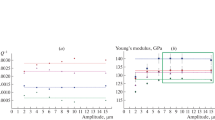Abstract
Special features of the effect of nonequilibrium defects, including dislocations on the activity and the structural instability of silicate systems, are considered. It is shown that the physicochemical properties of a material depend substantially on the phase composition, the presence of defects in the structure, and the treatment conditions. The hydration process is shown to intensify in the early stage of the interaction between portland cement and water. The suggested model of an “absolutely deformed solid body” makes it possible to take into account the structural defects, the level of the accumulated energy, and the activity of materials in the stage of preparing the raw components and the waste and in the production cycle of various silicate materials.
Similar content being viewed by others
References
V. S. Bakunov and A. V. Belyakov, “Prospects of improving the reproducibility of the structure and properties of ceramics,”Ogneup. Tekh. Keram., No. 2, 16–21 (1998).
Yu. D. Tret’yakov,Solid-Phase Reactions [in Russian], Khimiya, Moscow (1978).
Atomic Structure of Intergrain Boundaries [Russian translation], Mir, Moscow (1978).
V. M. Kosevich, V. M. Ievlev, L. S. Palatnik, and A. I. Fedorenko, in:Structure of Intercrystallite and Interphase Boundaries [in Russian], Metallurgiya, Moscow (1980).
A. A. Predvoditelev, N. A. Tyapunina, G. M. Zinenkova, and G. V. Bushueva,The Physics of Crystals with Defects [in Russian], Izd. MGU, Moscow (1986).
T. Sudzuki, X. Esinaga, and S. Takeuti,The Dynamics of Dislocations and Plasticity [Russian translation], Mir, Moscow (1989).
A. I. Orlov,An Introduction into the Theory of Crystal Defects [in Russian], Vysshaya Shkola, Moscow (1983).
G. A. Malygin, “Self-organization and localization of slip in plastically deformable crystals,”Fiz. Tverd. Tela,37(1), 3–42 (1995).
V. S. Eremeev,Diffusion and Stresses, Énergoatomizdat, Moscow (1984).
Ya. E. Geguzin,The Physics of Sintering [in Russian], Nauka, Moscow (1984).
Ya. E. Geguzin,Diffusion Zone [in Russian], Nauka, Moscow (1979).
P. V. Kovtunenko,The Physical Chemistry of Solids. Crystals with Defects [in Russian], Vysshaya Shkola, Moscow (1993).
P. V. Kovtunenko,Effect of Defects in Crystals on the Kinetics of Solid-Phase Reactions [in Russian], MKhTI Im. Mendeleeva, Moscow (1988).
F. M. Lenel, “The mechanism of transfer of substance in sintering,”Poroshk. Met.,6(24), 101–109 (1964).
H. Van Bueren,Imperfections in Crystals, Amsterdam (1960).
J. P. Stark,Diffusion in Solids [Russian translation], Énergiya, Moscow (1980).
E. I. Evtushenko, “Structural defects and the reactivity of disperse materials,” in:Problems of the Science of Structural Materials and New Technologies, Rep. Int. Conf. “Structural Materials, Building Industry, Power and Resource-Saving under the Conditions of Market Economy” [in Russian], 158–167, Izd. BelGTASM, Belgorod (1997).
E. I. Evtushenko, N. A. Shapovalov, Yu. K. Rubanov, et al., “A complex study of physicochemical and technological properties of slags susceptible of silicate decomposition,”Ibid, 76–81.
V. B. Vishnevskii, A. M. Ruzhinskii, and I. N. Godovannaya, “Hydraulic properties of slags,”Tsement, Nos. 1–2, 55–58 (1991).
Yu. E. Pivinskii, “New refractory concretes and binding systems: basic trend in the development, production and use of refractories in the XXIst century. Part I. Tendency of development, binding systems,”Ogneup. Tekh. Keram., No. 2, 3–12 (1998).
Yu. E. Pivinskii, “New refractory concretes and binding systems: basic trend in development, production and use of refractories in the XXIst century, Part II. Ceramic binders and castables,”Ogneup. Tekh. Keram., No. 3, 2–11 (1998).
P. G. Komokhov, “Mechanics and energy aspects of the processes of hydration, hardening and operation of cement stone,”Tsement, No. 2, 20–22 (1987).
L. A. Shuvalov, A. A. Urusovskaya, I. S. Zheludov, et al.,Modern Crystallography, [in Russian], Vol. 4, Nauka, Moscow (1981).
A. M. Kosevich,The Theory of Crystal Lattice [in Russian], Vishcha Shkola, Kharkov (1988).
V. R. Regel’, A. I. Slutsker, and E. E. Tomashevskii,The Kinetic Nature of Strength [in Russian], Nauka, Moscow (1974).
Author information
Authors and Affiliations
Rights and permissions
About this article
Cite this article
Evtushenko, E.I. Defects in the structure and properties of silicate materials. Refract Ind Ceram 39, 278–282 (1998). https://doi.org/10.1007/BF02765081
Issue Date:
DOI: https://doi.org/10.1007/BF02765081



